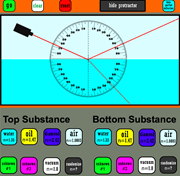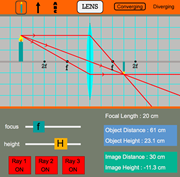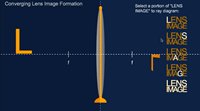Refraction and Lenses
 Refraction
Refraction
Turn on your laser and shine it through air at the surface of water. Change the laser's angle and observe the effect. Swap out the water and replace it with oil or glass or diamond or ... . Switch to the other side of the boundary and observe the effect of laser light traveling from water to air. There's no end to what you can try with this Interactive ... without an expensive laser, without getting wet, and without having to buy any diamonds.

Now available with two Concept Checkers.
 3D Refraction Sim
3D Refraction Sim
How light refracts and reflects when it passes through two mediums with different reflective indexes can be hard to calculate. This handy simulation let's you play with the ray angles and refractive indexes of two medium in order to see the reflection and refractions that occur.
Thanks to Physics teacher Martin Kirby for contributing this simulation to our Physics Interactives collection. Find more great Martin Kirby simulations
here.
 Least Time Principle
Least Time Principle
If you were a lifeguard at the beach and you saw a struggling swimmer in the water, it would be your objective to reach the swimmer in the least amount of time. But since you can run faster on the sand than you can swim in the water, you can't run directly at the swimmer. You can reduce your time by running a longer distance on the sand and swimming a shorter distance in the water. Your path to the swimmer will be a bent path - bent at the point where you transition from running to swimming. In this Interactive, learners will determine the entry point into the water that results in the least time. Then their analysis of the data will relate principle of least time to Snell's law of refraction. Now go save that swimmer ... in the least amount of time.
 Optics Bench - Lenses
Optics Bench - Lenses
Every child has had the fascinating experience of looking through a magnifying glass. Many of us have taken the magnifying glass and looked at far away objects only to notice that the magnifying effect no longer occurs. So what exactly is going on with the lens of a magnifying glass? In this Interactive, learners will explore a converging lens. A candle can be dragged to varying locations and the characteristics of the image can be quickly observed. There is an activity sheet to accompany this Interactive.

Now available with a Concept Checker.
The Physics Classroom thank their friends at
Nerd Island Studios for contributing this Interactive to our collection.
 3D Ray Diagram Sim
3D Ray Diagram Sim
Refraction is amazing, but who has time to calculate all those ray paths and lines? Wouldn't it be cool to just see them, and get a feel for how things like height, distance, focal length and radius impact the image? Look no further than this 3D Ray Diagram simulator!
Thanks to Physics teacher Martin Kirby for contributing this simulation to our Physics Interactives collection. Find more great Martin Kirby simulations
here.

"An image is formed by a lens when light from every point on the object intersects at a location in space." That's nice theory, but it's a little difficult to
get a mental grip on. But now that has changed with our Converging Lens Image Formation simulation. Tap the link and watch as our Interactive constructs the image of every point on an object using a rapidly-draw ray diagram. The process and the result will fascinate you. Tap the link and secure your grip on image formation.

Find out how a diverging lens forms an image. Tap on a point on an object and view the light refracting and being traced backwards to an intersection point. Repeat for a variety of object locations and learn about image formation for diverging lenses.